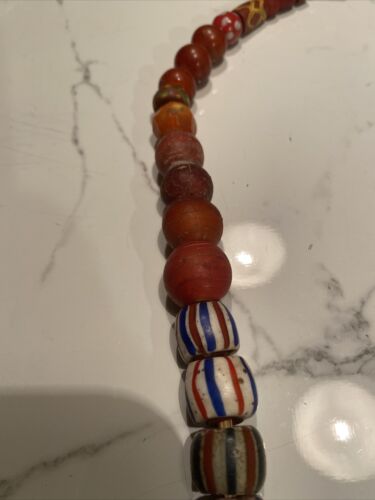-40%
Ancient Red Hudson Bay Trade beads. 22”
$ 121.44
- Description
- Size Guide
Description
One of the most prevalent types of multilayered Venetian beads is the cornaline d’Aleppo (carnelians of Aleppo) or white heart. Carnelian, a stone that is prized by many cultures for its deep red color, was used for centuries to make beads. Aleppo is a city in Syria. It is not clear why the glass beads were given this name; aside from the color, neither the stone nor the city has anything to do with the beads. The earliest examples, which were probably made in the 17th century, had an opaque red exterior and a green interior, and the thin tubes or small, round beads were produced by drawing or winding. In the 1820s and 1830s, the colors changed to a translucent red exterior and an ivory to white interior, and new shapes, such as larger cylindrical forms, appeared. Varieties with yellow centers made by winding (e.g., 70.3.217C) began to be manufactured in the 1830s. In later cornaline d’Aleppo beads, selenium was used to color the red glass, producing a strong orange- red shade. Exploration and colonization of the world by Europeans was a significant reason why Venetian beads became so popular and demand grew so quickly, beginning in the 15th century and continuing into the 19th century. European explorers quickly realized how much beads were revered by foreign cultures that were unaware of glass as a material. Beads were traded for diverse natural resources and land. Cornaline d’Aleppos were important trade beads for both Africa and North America. Some examples, including the ones illustrated here, were purchased in Ghana. They continue to be found on archaeological sites and in markets.The Aleppos in this strand have a yellow center indication manufacture around 1830.
There are some neat beads on this strand, The beads painted in the Chevron design lack the typical star configuration but do have a red clew
Ancient Red Trade beads. Venetian/Bohemian pre dating 1800’s. Condition is "Used".














